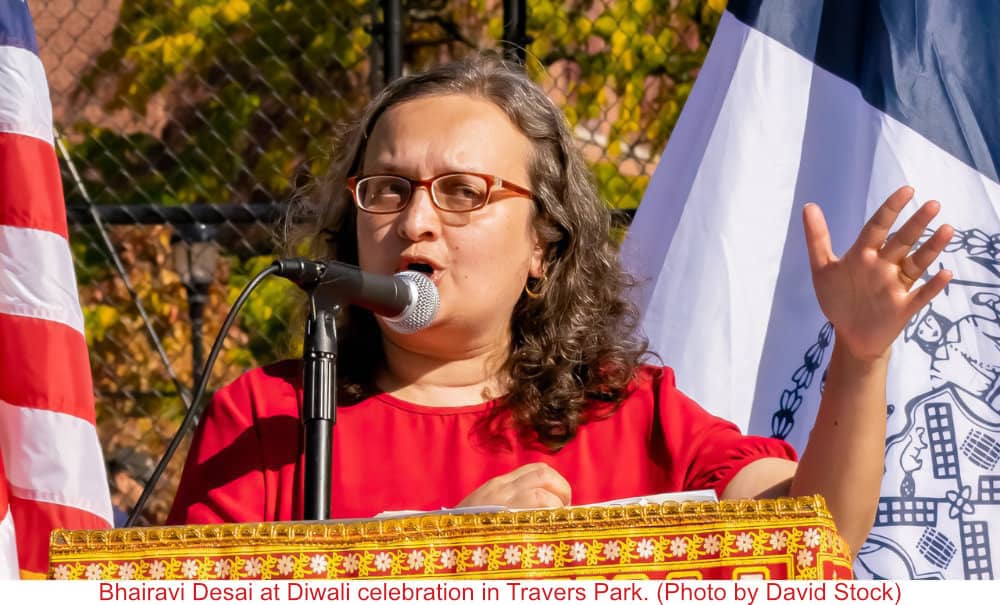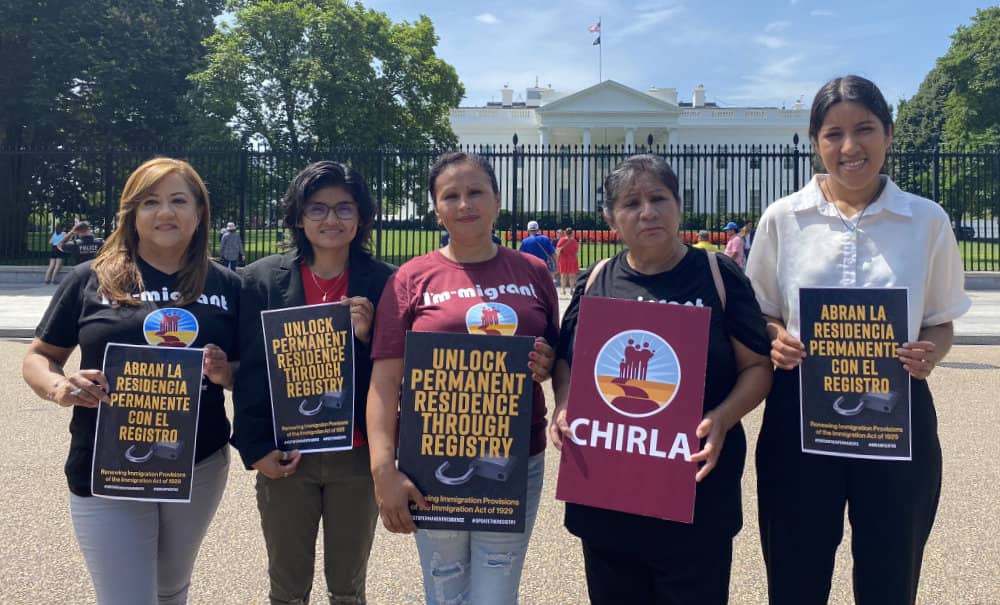Dear friends,
We write today’s newsletter at the intersection of local, national, and global politics—a dense intersection where all immigrants dwell. We update you on the current struggle of the local group Adhikaar to secure extended Temporary Protective Status (TPS) for members of the Nepali-speaking community, many of them neighbors here in central Queens. And we draw a connecting line between the imperial histories that drive current migration, and the national failure of the US to abide by international asylum laws. A source of immense human pain at the US-Mexico border, and in local immigrant communities like ours.
Please note that the JHISN newsletter also appears on our website in Spanish. Share the link!
Newsletter highlights:
- Asylum politics today
- Adhikaar fights for TPS
1. Asylum Is a Human Right
Step by step, the US and other wealthy nations are undermining the right to asylum—a vital right established by the international community in the wake of the horrors of World War II. Today, mainstream political discourse in the Global North treats seeking asylum as a crime and treats offering asylum as a burden.
>>Seeking Asylum Is not a Crime
US and international law clearly specify that any person can request asylum, and will be treated with respect and dignity, no matter how they arrive—including if they simply walk across a border. This solemn obligation has been reaffirmed by the federal courts, the UN, and the Geneva Convention.
It is the US government, not asylum seekers, that commits crimes when it:
- rejects asylum seekers on the grounds of so-called “illegal entry.”
- denies people legal status or makes them remain in Mexico without properly considering their asylum claims.
- “meters” the number of asylum seekers allowed to enter the US.
- forces refugees to make asylum “appointments” using an internet app away from the border.
- brutalizes and lies to asylum seekers.
>>Offering Asylum Is not a Burden
Imperialism creates refugees. Around the world, the US government and US corporations invade, provoke civil wars, export gang violence, generate economic devastation through “free trade” laws, destroy the environment, and sponsor dictators and death squads. These predatory policies, which profit rich North Americans and corporations, are responsible for chaos, violence, and persecution and cause millions to flee their homes. Ironically, the US admits far fewer asylum seekers for its size than many other nations. Our government also callously discriminates against those whose lives are impacted the most by imperialism, prioritizing expedited or privatized arrangements for refugees who have money, connections, or white skin.
Nevertheless, what politicians from both major parties prefer to talk about is how costly it is to host asylum seekers. These are the same “leaders” who promote subsidies for real estate interests and monopoly corporations—corrupt handouts which are bad for working-class people and staggeringly expensive. Politicians’ complaints about refugees inadvertently shine a harsh spotlight on their own lack of compassion and their comfort with radical inequality.
We are constantly lectured that we “can’t afford” asylum or any other social needs of oppressed people. We are told that “The Budget” is a zero-sum game with a fixed limit. But the wealthiest country in the world (and NYC, its wealthiest city) can certainly afford to welcome many more asylum seekers than it does today. To meet this need—this human obligation—there is really only one political decision required: making the rich pay their fair share.
2. Adhikaar Defends TPS before the Ninth Circuit Court
“The TPS extension has again given us temporary relief but we cannot continue our life on one to two-year increments. We have made the U.S. our home, and we are here to stay. We will fight tooth and nail to secure redesignations for all four countries and permanent protections for all.” —Keshav Bhattarai, Plaintiff, and Adhikaar Member Leader
As part of its anti-immigrant crusade, the Trump administration declared an end to Temporary Protected Status (TPS) for migrants who fled dangerous conditions in Nepal, El Salvador, Nicaragua, and Honduras. On Tuesday, June 20, President Biden reversed that decision, announcing instead an 18-month extension of the programs. As a result, existing TPS holders from those four countries will be protected until 2025 as long as they re-register.
Biden’s decision came just two days before a previously-scheduled hearing before the Ninth Circuit Court of Appeals in Seattle to review a major TPS case known as Ramos v Mayorkas. The plaintiffs are three Nepalis (Keshav Bhattarai, Saijan Panday, and Sumima Tapa) and two Salvadorans (Krista Ramos and Cristina Ramos)ee. Adhikaar—the Jackson Heights based group supporting the local Nepali-speaking community—plays a leading role in the case.
The history of Ramos v Mayorkas begins in 1990 when Congress established the TPS program, permitting migrants from unsafe countries to live and work in the US for a temporary, but extendable, period of time. Countries have been deemed unsafe due to natural disasters, political unrest, or armed conflict. Currently, there are approximately 400,000 holders of TPS in the US. Many of them have lived and worked here for decades.
When the Trump administration terminated TPS for Haiti, Nicaragua, Sudan, El Salvador, Nepal, and Honduras in 2017-2018, they were challenged by multiple lawsuits. A district court judge issued an injunction to prevent any of the terminations from going into effect, arguing that they were motivated by racism and failed to consider the current unsafe conditions in the affected countries. The Trump administration appealed, and in 2020 a three-judge panel of the Ninth Circuit Court of Appeals agreed with him that the injunction was improper. Lawyers from the ACLU, Adhikaar, the National Day Laborers Organization, and Unemployed Workers United asked for the entire Ninth Circuit to review the case, which they agreed to do, scheduling the hearing on June 22.
Once the Biden administration’s June 20 extension was announced, the June 22 hearing turned into a debate about whether the court should still issue a decision and if so what it should be. Adhikaar argues that the court should return the case to the district court, allowing it to reaffirm its original decision that the Trump terminations were motivated by racism and therefore unconstitutional.
On June 24, during an Adhikaar online town hall, Emi MacLean, an attorney on the case, reminded the audience about the intense anti-immigrant hostility coming from the Trump administration at the time of the TPS terminations.
“It’s important to remember how brave it was for people to come forward: those who were in the streets marching, those who went to Congress, and those who are willing to put their names on this lawsuit and share their stories publicly so the judges and the media and public would be aware of what was at stake and to force judges to make a decision about the legality.”
As things stand now, people from the four countries who had TPS protection at the time of the Trump terminations must re-register during a specific 60-day period to extend their TPS and work authorizations (EAD).
DHS will extend TPS as follows:
- Nepal from Dec. 25, 2023 to June 24, 2025 (60-day re-registration period: Oct. 24, 2023 – Dec. 23, 2023)
- El Salvador from Sept. 10, 2023 to March 9, 2025 (60-day re-registration period: July 12, 2023 – Sept. 10, 2023);
- Honduras from Jan. 6, 2024 to July 5, 2025 (60-day re-registration period: Nov. 6, 2023 – Jan. 5, 2024);
- Nicaragua from Jan. 6, 2024 to July 5, 2025 (60-day re-registration period: Nov. 6, 2023 – Jan. 5, 2024).
The National TPS Alliance and immigrant advocates are pleased that Biden reversed Trump’s plan to end TPS. But they are pushing the administration to do more than just extend the deadline for those who were already covered. They want him to “redesignate” the four countries, resetting the clock to include new immigrants in the program. They are also lobbying Congress to grant a legal pathway to citizenship for TPS holders. In the meantime, a ruling from the Ninth Circuit is awaited.
WHAT WE CAN DO?
- Support Adhikaar’s work to secure TPS justice.
In solidarity and with collective care,
Jackson Heights Immigrant Solidarity Network (JHISN)
Follow @JHSolidarity on Facebook and Twitter and share this newsletter with friends, families, neighbors, networks, and colleagues so they can subscribe and receive news from JHISN.




